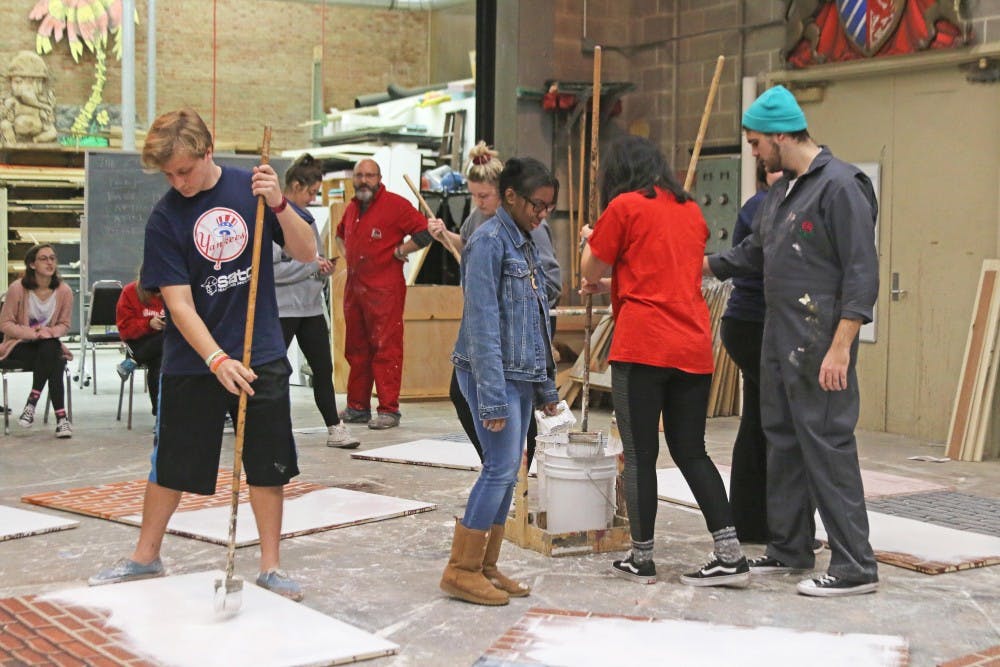https://youtu.be/1r9EPWc2CD4
Video: Nikki Saraniti
In room 139 in the Center for Performing Arts, there are no desks. The only chairs in the room are stacked in a corner and are only used from time to time.
The ceilings are high. The cement floor is covered in dried patches of paint.
Twelve students file in every Tuesday and Thursday at 10:05 for Scene Painting Fundamentals. They're dressed like any other students around campus wearing sweatpants, gym shorts, jeans, t-shirts and sweaters -- but their shoes are marked with drops of dried paint.
Their professor, Gion DeFrancesco, is wearing a red jumpsuit emblazoned with the Miami logo, also splattered with paint.
Gion (pronounced like "John") has spent the past few classes teaching his students about bricks. He told them to do some research, to look at different types of bricks and to bring in photos to reference for their project.
In Thursday's class they were finishing up their brick study. The students grabbed their half-painted flats, spread out around the room and set them on the ground next to reference photos slid inside plastic sheet protectors. Then they went to the back corner of the room, which was overflowing with paint cans and buckets lining shelves and stacked up on the floor, to mix their paint.
Half of their flats were covered in "hard bricks" -- bricks in red and brown hues with straight lines and crisp edges that were uniform in size and shape, like the bricks adorning the exteriors of Miami buildings.
On the other half, students were to paint "soft bricks," bricks with rounded edges and less harsh lines that looked older and a bit weathered.
"I have to relearn what I did last time," said junior Gina Moravec, a professional writing major with a media and culture co-major and theatre minor, observing the half she had already finished.
Where her neat rows of brown bricks stopped, she filled the rest of her flat with grey paint, lighter in some parts and darker in others, since brick walls are seldom one uniform color.
Enjoy what you're reading?
Signup for our newsletter
She dipped her paintbrush into one of her small white buckets of dark grey paint, then drew a splotch on the floor get rid of any excess.
She began dragging her paintbrush across her flat in semi-straight lines. These would be the outline of the bricks -- or the mortar, if we're talking in technical brick terms.
The students used regular paintbrushes attached to long bamboo sticks with rubber bands to make them taller. This let them stand up straight while painting as though they were sweeping a floor; it also saves painters' backs from bending down for hours.
After Gina finished making the outlines, she lined her bricks with lighter and darker shades of grey. These created a highlight and cutline, which is what makes the bricks appear 3-dimensional.
In scene painting, you have to consider how a painting will read from far away. Even the closest person looking at the painting will be at least 20 feet away in the theater. You have to make it stand out while also considering how it will work with the lighting and other elements of a production.
As they work, the room is silent except for the constant whir of a fan sitting in the corner and Gion's intermittent words of encouragement.
"No one's is going to be perfect," he called out. "We're learning about process. If I tell you how to do it one way, it doesn't mean you did it wrong."
One by one, the students began leaning their flats upright against the walls as they finished.
They took pictures of their work with their phones, pleasantly surprised that their bricks looked even more realistic in the photos.
The class gathered in the center of the room and went through each of the flats lined along the perimeter.
Junior theatre major Abby Chafe's soft bricks had some orange hues to them, a color that Gion admitted he was skeptical about when she started, but thought turned out well.
"I feel like I could bounce a ball off that wall," one of her classmates complimented her.
They went through each person's work, noting the things that worked and those that didn't.
Then, each student retrieved their flat and Gion told them to paint over half of it with white paint so they could use the space for their next project.
Everyone began sweeping a thick layer of white paint over their boards, upset that they had to cover half of their hard work. Meanwhile, Gion stood by the rolling chalkboard, ready for their next lesson.
Stones.
fentermc@miamioh.edu




